To Greece and Greek Islands, 2005
May 14 - Landed at Athen
Inspired by a Taiwanese travelogue book titled ‘我的心遗留在爱琴海’, I seized a rare opportunity of taking a long vacation to go Greece and its neighbourhood, Greek Islands Taking a midnight flight and surviving through intermediate sleeps, I landed at the international airport of Eleftherios Venizelos in Athen. The first destination was Crete, the largest and most southerly Greek Island of all. Since a domestic flight (EUR101) to the island was an expensive option, I reserved a second-class cabin (EUR35) in an overnight cruise through a helpful modern lady from an airport travel agency, together with two nights at this Hotel Helena in Crete. To reach Port Piraeus, I bought a ticket (EUR2.90) at a kiosk and boarded bus #96. In an hour or two of slightly stuffy journey, I landed myself at the port parked with gigantic cruise vessels of different chimney colours to distinguish various companies. I deposited my haversack at a paid locker and roamed freely to capture len images in my first day at Greece. After a hearty dinner at a snack bar, I made a long detour to my designated vessel, only to discover later that a shuttle bus service around the port was provided. In the vessel, I shared a congested room of four beds and private bathroom together with two middle-aged locals. They were friendly but I understood little of what they said in their own Greek language. I knocked out effortlessly to recover my deprived sleep last night. The humming ship engine was a lullaby to me while it cruised southward through the Aegean sea in the long darkness...
May 15 - Crete (Knossos Palace)
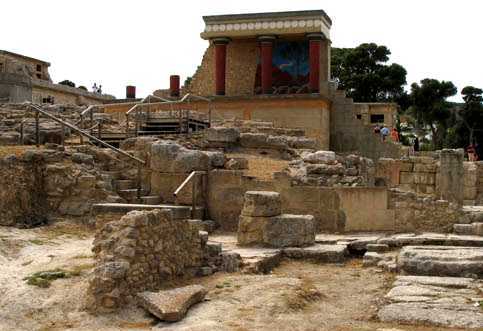 |
|---|
| Knossos Palace |
Before the crew member knocked on the door, I was wide awakened by the sheer excitement of exploring the Greek Island. Out of the ship at the Souda of western Crete, the infant sky was tinted orange by the rising sun. I hailed a metered cab for EUR7. I was informed that any cab driver could take any passengers along the way, regardless whether you like or not, so it came no surprise to find sooner an aged lady passenger with grocery bags sitting at the front seat. Within minutes, I was dropped at the edge of Hania old town, clueless where Hotel Helena was. I wriggled for an hour in the tangle of narrow streets at Splantzia quarter filled with narrow hotels and cafes. Sign boards were confusingly everywhere but slyly hidden behind flower pots or corner turns. The whole town was sleeping in early hour with few people roaming around. A slow grandma with an intent to persuade me to stay at her lowdown hotel, kindly instructed me the way. However, at a miss of a narrow turn, I was back to the coastline again. I began to feel the haversack weight on my shoulders and attempted into the maze again. Lucky enough or not, I finally found the hotel yet it was not opened! To kill time, I sat on the cafe table, facing the sea of Old Harbour and ordered a full set of breakfast that came with nice orange juice. It was indeed a nice warm-up for the exploration of Crete.
When I returned to Hotel Helena, the hotel staff was unexpected of my arrival. After mumbling through a phone call, she explained to me that there was a mistake and I was actually assigned to another neighbour Hotel Porto Del Colombo. She escorted me to the actual hotel and to my dismay, I had to wait til noon to check in my room. And thus after accomplished an hotel seeking mission, I was yet entitled to a nice bed or a hot shower. To save time, I left my heavy baggage at the counter and started my actual exploration on Crete.
 |
|---|
| Hania |
Knossos Palace, the capital ruin of ancient Minoan Crete, was recommended highly in every guide book and I was lured to check it out, even if it meant travelling from west to east of Crete. The bus terminal was minutes away from the hotel and I had to get an computer-printed ticket from the counter before boarding. Sitting on the spacious, air-con tourist bus was an experience in deep contrast from the hair-raising bus ride in Nepal. Though I had no complains on the comfort of the bus, I had regrets on taking a 4.5hr journey which bypassed Rethymno, the third larger Crete town before reached near the sea port of Iraklio. Bought two-way tickets from a hidden kiosk, I boarded internal shuttle bus #2 to Knossos at the outskirt of Iraklio town. Trying to satisfy my hunger, I got myself a slimy fruit cake, only to find it ineatable due to its high sugar contents. My stomach cried out for a decent meal and so I yearned myself to a not-so-cheap restaurant for a fried squid set near the entrance of the Knossos ruins.
The Knossos palace of ancient Minoan civilization, was unravelled by Sir Evans. Sir Evans reconstructed the site to enhance the visualisation of the palace glory. As a result, I was bewildered at what I was appreciating -- the giant ceramic jars, crumbling brick walls, fresco paintings of charging bulls and blue dolphins, black pillars rimmed in red, were they the real things or just duplicates? Were I visiting a real open-air museum or just a mock-up stage? It was quite a small excavated area, which added doubts over the purpose of visiting, perhaps I was less of an archeological type. Losing interests quickly, I soon backtracked by to Hania for another five hours. I admitted that the visit was unfulfilling and much time was wasted over travelling, yet I was optimistic that more and better places were installed for me in many days ahead.
On the contrary of sleepy scene in the early morning, Hania old town was transformed into a 'happening' night like Clark Quay in Singapore when I reached in the evening. I swiftly brought my baggage to my room and rushed down to the Old Harbour. Along the water lined with busy cafe where waiters were snatching customers. People were everywhere: immobilised clown, flower-selling boy, horse-carriage chauffeur, loner lying at the pier and drumming to mind his own business. I walked furthur towards the Mosque of the Janissaries which its domed rooftop shaped like an octopus. I anticipated a sunset as a backdrop of a renovated lighthouse perched on a protruding long and thin coastline for my lens. At the harbour where several yachts were parked, I headed back to my cosy room and had my long-awaited bath at a nicely tiled bathroom...
May 16 - Crete (Samaria Gorge)
Negotiated at a travel agency the day before for a trek at Samaria Gorge, I woke up early to catch a coach bus filled with other people with alike agenda. Though the Gorge was just south of Hania, the journey was no less shorter as the bus wriggled through the uphill contours. A young short lady with tight athletic wear introduced herself as our guide in fluent English and French. After having a breakfast stop at a snack bar, she issued us the ticket at the Samaria park entrance and set us free to walk on our own while she trailed at the back.
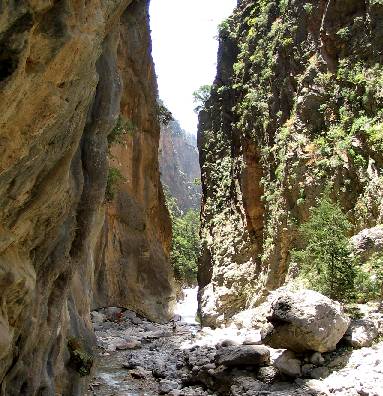 |
|---|
| Did I cross the Iron Gate walls of 3m apart? |
The trail started from Xyloskalo, a steep staircase descending deep down to the gorge. The ground was ambushed with loose gravels and slippery rock; I occasionally gripped the wooden railing to guarantee my foothold. Being at the terrain topmost, I admired the dreamy sight of mountains after mountains blurred by morning fogs. Distorted pine trees hanging precariously over the cliffs provided some shades along the rocky path. Trekkers were spoilt with several rest points providing hut toilets and drinking fountains. After crossing one or two river beds with little stream, I came to the Ayios Nikolaos, a small bricked chapel and chewed a snack bar as lunch. Here I encounter a Greek couple who had been visiting Crete for days by bike. The outspoken lady, in her good English, recommended some places to go, while her quiet partner in his biky suit extended his friendliness by taking pictures of us.
I moved on. Crossing a number of small river did not impede my walk to arrive at the Samaria village for another rest. It was now deserted of few empty houses and brick-walled fences. No more villagers, just resting tourists. Around mid-afternoon, I had found myself at the base of high rock walls vertically split by a narrow passage. This Samaria Gorge was supposedly the longest (18km long) and deepest in Europe. The sun was scorching but it was tolerable by the conventional winds which blew heavily and noisily through the split-way. The cliffs displayed different rock formations and colourful flora. I passed through several wooden bridge planks over the low-running river. I was so engrossed watching my steps that I missed awaring the famous Iron Gate which the walls was just 3m apart. Nevertheless, I suspected I did cross the narrowest passage as my snapshot told me so.
The trail was getting uncomfortably hotter, causing many trekkers to bare their bodies. Still, with proper footwear, the trek descent, which took no more than six hour, was not strenuous as I thought. The far south of Gorge was my end-point, in reverse was a starting point for those some hard-coded trekkers shouldering big bags to climb all the way up north. I rewarded myself with a nice cold coke before heading along an improved tar road to a touristic Agia Roumeli packed with resorts and cafes. The lady guide claimed I finished too soon and the ship to Sougia only left hours later. So I tried hard to kill my time by taking two meals at two cosy restaurant, regretful not to bring my swim wear for a dip at the pebble beach riddled with colorful umbrellas. The ship sailed for less than a hour to Sougia, from where a coach bus was waiting to bring the same group back to Hania. Back in Hania, it was another bustling night. I chose a quiet corner at the fast-food cafe for my dinner.
May 17 - Crete to Santorini
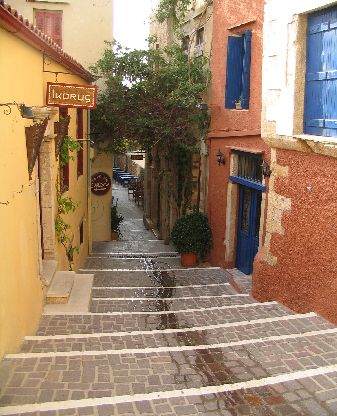 |
|---|
| Backstreet of Hania |
A few hours before I departed from Crete via an afternoon cruise, I had a early stroll along the atmospheric backstreet of old Splantzia Quarter in Hania. At the east was an ancient fortress wall, abandoned and nothing spectacular. I preferred to lose myself in the labyrinth of Hania streets. I began to appreciate its unique beauty. Every turn revealed new decorations of the shops and cafes -- pots of brillant flowers, crafted signboard, sky-blue door and windows; they were cramped but not messy. Few locals were awoke. A lady was laying out her craters of fruits and stacked in front of her grocery shop. An old man was dumping rubbish into his mini-truck. A baby was sitting on a gentle staircase, clapping and waiting for her mother to fetch her into a bike. There were no hurry, no conflict.
I trailed furthur and climbed up the Promahonas hill, a good stop to oversee the Hania landscape. Not far eastward, a Minoan evacuation site was situated in the midst of Venetian houses. A young archeologist student sat on the dirt, chiselling listlessly on the buried rocks. Guess not every archeologist was as exciting as Indian Jones. I was then back to the harbour parked with yachts and yellow tourist submarine. The blue sea sparkled under the glaring sun, brought a few backpackers to idle by the pier. For any visitor of Crete, Hania was a must-to-go paradise.
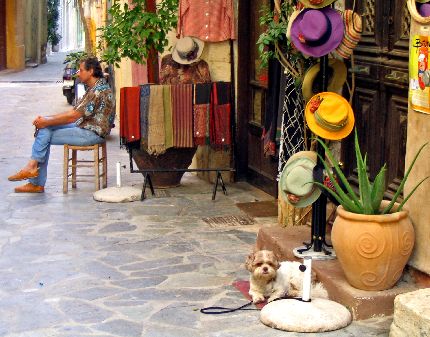 |
|---|
| Hat and Dog |
I took a bus to Iraklio where I later boarded a cruise to Santorini. Holding only a non-cabin ticket, I was only entitled to sit on a couch beside the bar, writing my first journal of this trip. By late afternoon, the cruise sailed gradually to the Athinios Port of Santorini, with reddish-brown cliffs as the backdrop. Santorini, also known as Thira, was actually a submerged crescent-shaped caldera under the work of historic volcanic eruption. The moment I set foot on the land, I was overwhelmed by tourist touts aggressively promoting hotel rate. One of them, Steve, middled-aged, plump but swift in action, pushed a brochure to me and advertised highly on his hotel at the Fira town at a very low price. I was attracted by his too-good-to-be-true offer and followed him into his van. (In this non-peak season, finding a cheap hotel rate was easy.) On the way to his hotel, the van snaked up contours of the cliffs. As elevation was gained, there was a spectacular view of sunset over the vast Aegean sea torn by ripples created by the departing ship, which brought me to this wonderful island. Steve brought me into the town, as confusing as Hania alleys, if not whiter and more beautiful. He guided me to his homestay hotel, disclosed at one unknown corner with no reception. The room he offered was, nevertheless, cosy with small balcony facing local neighbours. After bargaining at merely EUR35 for two nights including breakfast, I believed I struck a good deal with him at his Emmanoulela Studios. I settled my dinner near the accommodation at a family restaurant which baked slewed fried fish with charcoal. The environment was tranquil. The road was nearly empty except some mischievous teens making their bicycle stunts. If I had my driving license, I would love to explore around in one of those tiny 'smart cars' that offered no backseaters. Many locals owned them and painted with striking colours and textures.
May 18 - Santorini (Fira, Kamari)
Facing outside at the balcony in early morning, I watched an old lady busy with her usual chores of sweeping her house rooftop and feeding her chickens with soaked bread scraps. Right besides were two glaringly white churches topped with sky-blue domes at which tiny crosses perched -- such churches were everywhere in Santorini to form the island landmarks. Steve's mom, plumper with approaching smiles, room-serviced me with a tray of coffee, hard bread and omelette. I brought my meal to the balcony and enjoyed the early sunlight, before I headed to Fira town. By reading at the guide book and maps, I realised that I was fooled by Steve into thinking I was in Fira town; I was in fact stayed in Karterados village, 800m away from Fira! Nevertheless, such outrageously cheap hotel price still impressed me, given my limited cash flow and high euro dollar rate.
 |
|---|
| Fira |
Walking for some 20 minutes, I had reached the bus terminal of Fira town from which scheduled departures to various towns in Santorini. I snapshot at all the bus timetables on a notice board, to obtain future references on my digicam monitor. Some American tourists noticed me, discarded the outmoded way of writing down on notebooks, and followed my witted acts. Before going elsewhere, I chose to explore the town. The first stop was the Museum of Prehistoric Thera at absolutely no admission fee due to its ongoing renovation. It exhibited numerous findings excavated from Akrotiri, including pottery jars of different sizes, frescos depicting monkey mischiefs, and most beautiful of all, a glittering gold ibex figurine in palm-sized. Then it was time to explore the labyrinthine streets of Fira. The first sight was a bieged Orthodox Cathedral where a nun forbade me to enter its premise due to my improper dress code. (I was wearing bermuda.) I did not feel at a loss as the sea view in front of Fira town nested at the brown caldera edge was uniquely gorgeous. There was a myriad of restaurants, hotels, souvenir shops. Fascades were erected alone facing the sea front, down below was the staircases to the messy cluster of hotels or cafes. No road sign existed as it served no purpose in the disarray of twisting alleys and corners. Souvenir shops were everywhere selling miniature mules, sea sponges and magnetic Santorini pictures. Walking down a long zigzagged flight of pebbled stairs towards the Old Port, the blockage of mules parked alongside and their massive wastes accumulated in every step deterred my descent. Finally, I gave up walking because of the unbearably strong pungent smell and dispersing 'landmines'. I could either pay for a mule ride down or go back to the upper street. I chose the latter. I wondered whether those old mule owners deliberately made the walk difficult to gain more businesses?
Penetrating through the narrow lane was more cafes and shops, touting any bypassers. There was a cable car station to get people down to the old port within minutes, judging from its pricy ride fee of EUR3, I chose to stay on top admiring its scene where big ships were coming and going. Near to the north end at a Catholic church, it was less crowded and an white-capped artist enjoyed its quietness to watercolour his postcard-sized piece. I sneaked into the sacred church with exquisite altars and chandeliers, and stole some shots when there was no one noticing. My stomach grumbled and I backtracked to have lunch. Sitting at the second level of a restaurant, I indulged myself once again on a fried squid plate while peeping down at the flow of tourists along the confined path.
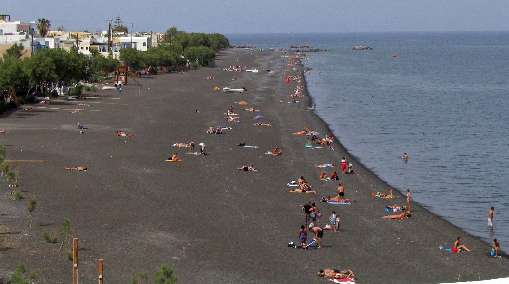 |
|---|
| Kamari beach |
Declaring that I had enough of Fira town, I got a few spare hours to roam around before nightfall. Returned to the bus terminal, I decided to visit another site, either the renowned Oia town or the beach of Karami. Saving the best for the next day, I chose the latter by going there via a tourist bus at only 1 euro. Karami possessed a long stretch of black-sanded beach scattering with people lying flat reading books or simply tanning themselves, with their swim wears or nothing at all. The atmosphere tempted me to dip but I resisted, simply because I was equipped with several water-shy electronic gadgets except my swimming trunk. At one end of the sand was a white church leaned against a rocky cliff. Two boys were standing precariously at the cliff edge, the one wearing white boxer dared to jump into the water, later challenged the hesitated one who finally dived under peer pressure. I went to a small cove near where they jumped to get a good overview of Karami, and a few swimmers baring their upper bodies! A Western photographer appeared later and focused his lens of high optical zooms on the half-naked ladies! I chuckled at his naughty intention.
I strolled indifferently at a row of touristic shops and restaurants alongside the beach before heading to a bus station made up simply benches and crooked pole posted a bus icon. It took as long as half an hour before the vehicle picked me up to Fira town. Then it was a slow walk back to my hotel, stopped halfway and lured by the sight of roasted golden chickens stewing and rotating in an oven for a hearty dinner.
May 19 - Santorini (Oia)
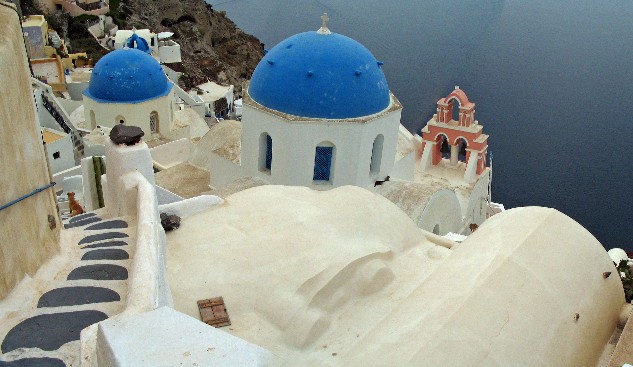 |
|---|
| Turning corner of Oia |
It was the same kind of breakfast served, from the same lady with her usual tender smile which I never grew tired seeing of. Hanging against the wall was a sea view picture of Oia titled 'the most beautiful sunset in the world', I had to find out myself whether it was mere exaggeration. Again, I walked to the Fira bus terminal to hitch a ride to Oia situated furthur north of Santorini island. It did less than half a hour to reach the much anticipated Oia, where I was firstly welcomed by several lady shop owners to introduce their sweet-tasting orange wine. Shouts from the children lured me to peep at a kindergarten where they formed circles, inner and outer, hand-in-hand, arousing their excitements by chanting loudly. Not far away was a small square of many steeply-leaning trees, one of which became a lying support for a man to read his newspaper. Nested even higher on the caldera edge, the whiter Oia was more scenic and tranquil than the tourist-frenzied Fira. Lesser vehicle road, it had more narrow passageways and curling steps. In the early morning, there were lesser people walking by, though few locals had started to paint their doorframes or stairways, brightening their shops or hotels in white and blue to lure patrons.
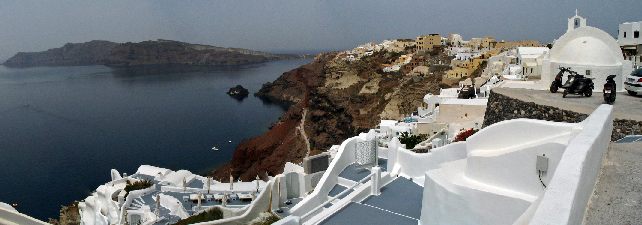 |
|---|
| Oia Overview |
Oia lived up its reputation as one of the most beautiful place. Every turn and corner brought astounding aesthete, with the main theme of blue and white. Oia was a maze of houses clustering and stacking tightly, originally intended to confuse intruding pirates. Sometimes while losing my way, I was uncertain whether I was stepping on any balcony or rooftop of someone's residential houses, unless there was signboard to retain my footstep. Every house gardened in its limited space with blossomed flowers of brillances. The cafes and hotels drew attentions by not only painted their limited fascade with bright colours, but decorated with unusual objects such as small yacht parked at the rooftop or mesch-wired bicycle hanged above the doorway. The village satisfied to those who wanted something artistic back home, as there were many shops selling unique art pieces made by local talents.
Dogs were everywhere in Oia. Most of them minded their own business, up to an extent that they slept and laid wastes even in the middle of the visitor paths. I was one of the unfortunates to step on their droppings carelessly when searching for good scenery. Neverthelss, they often added liveliness to camera pictures at the backdrop of Oia. Take for instances at a backyard of a large bieged Church, I adored this furry dog which wagged its tail continually to welcome my presence, but instinctively remained still while I clicked the camera. At a clock tower, a giant huskie stood majestically, receiving the awes from the visitors. As there were many idle dogs in every corners of Oia, there were many cats as well crouching quietly on the fence walls, living peacefully together within the same neighbourhood.
 |
|---|
| Sunset in Oia |
The sky was curtained in grey with occasional drizzles, therefore I feared that sunset view might be mercilessly blocked by clouds later. Nevertheless, I gained this timing opportunity to obtain photographs of proper exposure in the afternoon. The white dwellings, the sky-mirrored sea spouted with sailing ships compelled me to take endless pictures, so much so that I ran out of power and had to decisively buy four AA-sized batteries before the sunset highlight. In late afternoon, foreigners began to flock in as tour groups and inconsiderably blocked the narrow passages, hearing what the guide had to narrate. After a hasty dinner, I was searching for a good spot to wait for the much-anticipated sunset. There was a jutted edge with no accessing road, I attempted to bash through the bushy ground over the cliff, yet in the end gave out its unreachable spot. Then I snaked through a small pavement into the wonderful area close to the symbolic church of two blue domes and orange stands hoisting multiple bells, a popular landmark of Santorini which I sketched. It was still early so I let my legs to rest, interrupted by an Australia couple who politely asked for my assistance to take a picture of them and exchanged information about Greek islands, and two China sisters constantly posing in front of their camera while commenting loudly. Later, two kids and their huge dog converted this place into their playground where they climbed up and down over awkward ledges while their pet was mischievously chasing and biting them. The boy smiled at my presence with eyes narrowed, revealing some of his missing tooth. His blond girl companion, had a stern look of beautiful facial features with her soulful eyes. They continued to enjoy amusing themselves in front of an Asian adult, occasionally playing out their in-prompt script about princess and heroic knight.
I became restless and decided to find another sunset-seeing spot. Up north was a ruined fortress, what remained was crumbled walls but was a popular area attracting visitors to come. Fortunately, the fortress trespassers were relatively few, waiting patiently and holding their camera up for the sunset. It was double blessing when the orange globe was visible enough, penetrating through the shroud of intense clouds. The visual impact through the synergy effect of white clump of Oia settlements, the calm sea littered with yachts and the lowering sun spotted on the cloud curtain was unbelievably captivating. All the sea-moving vessels came to a halt as well, admiring the awe of the moment. The hue was changing from orange to pinkish red as the sun migrated to the horizon. To resist the darkness the Oia houses and streets were lit up, and the ambiance smoothed my heart after hours of walking. Dwelled in the fast-paced Asian city, I was always fascinated by the carefree and romantic characters persisted in Europe. From the evidence of this day, perhaps I knew the answer, it was nurtured by the nature and architectural workmanship. Nobody could resisted not having hearts lighten up in this place.
I yearned a longer stay in Oia to enjoy its night view. However, reality bite came in as I needed longer time to reach my distant hotel. There were no bus around in late night and I had to take an expensive cab ride. Although I agreed with the cab driver over a fixed rate, he gave a discount in the middle of drive along the cliffy highway with no lampposts. It remained a mystery to me still on his abrupt kindness. Maybe after seeing my jovial and satisfied expression, in his limited English command, he had to agree with me in other way, that Oia was extraordinary splendor.
May 20 - Santorini to Meteora
This day was nothing more than getting places to places. Steve gave me a hitch ride to the Athinios port along the same winding road on the red cliff side. I had my last glimpse of Santorini's outstanding sea view, the more I admired it, the more I wished dearly that my partner would be there. However due to time incompatibility and mistakingly rush arrangement, she was not with me this time around.
The sea journey back to Greece mainland was about six hours, thus I had a whole afternoon in the vessel cabin. To kill this time, I got myself a second-class cabin with bed and prepared to have an afternoon nap. A staff escorted me to my room and chatted with me of some general weather topics. Apparently his intention of friendliness was clear once he sought for a tip at my designated room. The room had a double-decked beds and a big and out-of-placed wardrobe which resonated occasionally with the engine sound as the ship sailed. Unfortunately, my nap plan failed as I caught little sleep because the air vent was blowing fiercely and my bladder lured me to the outside restroom several times. Eventually, I had to resort to the music of my MP3 player and stared blindly at the ceiling. If only there was an overnight vessel schedule, I would not have wasted such precious time. Therefore, it was very important to keep abreast of the timetable to adjust the itinerary in Greek Islands.
By evening, the ship was within sight of the Pireas port. Shrouds of lightray penetrated through the thick cotton cloud by the artwork of the descending sun. Seagulls were chasing desperately on the ship velocity. Once I touched down on the land, I had a swift walk to the railway station, hopefully to find a earlier schedule to Kalambaka, a town just hill-foot of the famous Meteora. I was told at the counter that I had to take a train to Athen first and got another one from the city. I snatched the ticket and got in the last minute of the departing train, only to discover that I aboarded wrongfully onto a first class cabin. Luckily, there were very few passengers who would find my presence incongruent. However, one of them was kind and friendly enough offer help. He was a middled-aged businessman, in his excellent English, informed me about the tips of going around Greece. Despite his formal business suit, he held no air over me with a shaggy outfit and heavy backpacks. However, I did not receive that level of helpfulness as I approached another guy at railway counter for the direction to Kalambaka. He tried to explain to me where to transit and which cabin number in a fed-up tone. I gave up seeking more clarification and had my dinner at the railway cafe. The cafe was a haven for backpackers; I met a Singaporean couple, who intended to visit Albania and Turkey separately, (I was informed in the end of trip that they did not get to Albania without a visa permit.) and a Taiwanese couple who liked to play around with their SLR camera. At the train waiting room, there were a lot of people of various expression, but all with an anticipating heart to the train arrival. A Mr-Bean-like man with a supported neck, smiled at me and spoked no words, gladly showed me his neck bandage. An Albanian family of five looked darker in their facial expressions.
While the train information service was not discouraging, the train seat allocation by the confusing ticket number was perplexing. I guessed these were due to the fact that the railway was monopolised by a single company. The train was quite packed. Through the window, I saw very few night views as it passed through the countryside of little lights. I slept instead on the seat with folded arms. In the middle of the night, I woked up with sluggish heavy eyes and dropped at a transit stop. Followed the locals who went through an underground tunnel and waited at the other platform side, I was picked up by another train which speeded directly to Kalambaka for an hour or so. It was as early as four am when I reached the town which looked deserted in the nightfall. Strong chilling winds initiated me to look desperately for a hotel. Therefore, burdened with two baggages and resisted against the declining temperature, I walked solely on the empty road, searching the 'HOTEL' word in any neon signboards. Without second thought, I walked into the family hotel, Aeolic Star Hotel, at the side alley, rang a bell to interrupt a madam's sleep. Notwithstanding that she was little frustrated over my intrusion, she was still kind enough to pass me the keys after room inspection and hastened me to sleep now. After a warm bath, I managed to steal some sleep before a new discovery of another new place.
May 21 - Meteora
In the late morning, I began to appreciate the simply tranquil living of the Kalambaka when I went out for my early lunch-cum-breakfast of roasted chicken. It was a small town of sloping roads straddled with low houses near Meteora. Meteora reputed itself of its special rock formations, where several Orthodox monasteries were constructed by 11 century monks on top of vertical rock pinnacles. To get here cheaply, there was two bus trips in the morning and afternoon. I had overslept and missed the morning bus, thus I took a cab which the driver touted me while I was checking the departure times in the railway station. He offered me to tour every single monasteries, but I declined and accepted only a one-way ticket to the topmost monastery, Megalou Meteora (aka Grand Meteora).
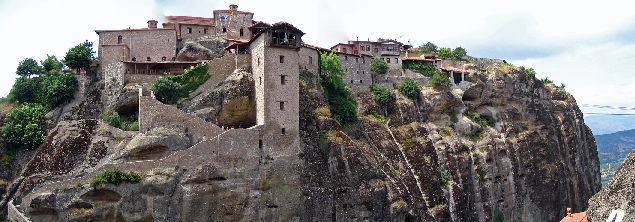 |
|---|
| Varlaam (left) and Grand Meteora (right) |
The Grand Meteora was not only the first among the surrounding monasteries, but was the highest and grandest of all. At the entrance, souvenir shops were waiting to be patronized. It was a long zigzagging staircase, passing through a cave, and up to the finest Greek Orthodox church. The first sight was the ascent tower, an outlet where goods and people were hauled up in a net and winched up by a windlass mechanism, the anceint way to overcome the height and reach the monastery Piling skulls of ancient monks were stored up to commemorate for their excellence in spiritual practices. Halls had transformed into museum showcasing the art of Orthodox Hellenism such as the intricate wooden crosses, icons of Christian figures. Wandering around the museum, the resonating music of humming chants in the background added mystic element. To appreciate the ancient monk-hood lifestyle, I visited the cellars exhibiting traditional pewters and huge wooden barrels, as well as the smoke-blackened kitchen housing primitive bread oven and soup-hearth. The altars, forbidding any picture taking, were walled with frescoes depicting the story of Jesus Christ and Virgin Mary.
Round the bend of the road was the Varlaam, another established monastery which was named after a monk. To access it, I made a detour around a rock outcrop. It kept many sacred relics much of the same kind as Grand Meteora, but of small scale. The next monastery was the Roussanou with a photogenic scenic background. I climbed up the stair to glance around, overseeing magnificent landscape of rock formations and town layout. Though I did not enter the domain, I tried to understand it by overhearing a tour guide explaining this place to an English tour group. Next I backtracked down the road towards Kalambaka and bumped into the Taiwanese couple whom I separated the day before. They had patiently toured each and every monastery with a goal of understanding deeper where ever foreign they had set afoot. I liked their stubbornness, which put a utter shame to those who blindly hunted for good scenic pictures and arrogantly ignored any appreciation of the local culture. I never explored deeper on Meteora to ensure the trip was conducted smoothly, thus, part of me I was ashamed, part of me I learnt. To uphold the joy for the remaining trip, it was also regretted not to proceed to the west side of Meteora where there was the Monastery Agias Trias, a film location in the James Bond's 'For Your Eyes Only'.
Walking alongside the car track, I noticed on there were a few rock-climbers clinging on a soaring black rock surface for hours. Judged from their distant size as small as ants, they had a very long way up. I believed that while the ancient pilgrims might have scaled up the rock like those rock-climbers, both groups had different passions. While the ancient ones did it in the name of spiritual pursuit of perfection and then constructed those monasteries of great significance to last for many decades, the modern others performed it for their personal challenges and sheer adrenaline, in their present lifetime. Both group were to be admirable, but at different scale.
 |
|---|
| Monastery of Rousanou |
Bypassing the monastery of Saint Nicholas Anapaphsas, I came across the serene Kastraki town with a panoramic backdrop of Meteora rocks. After an hour and so of foot fatigue, I returned to Kalambaka. The town was small enough to shorten its visit, nothing spectacular though. I consumed my dinner at the outdoor table and scanned my guide book to search for my next destination, while a fluffy dog owned restaurant staff conveniently laid beside me, oblivious of the chicken bone I threw to it. As my wilful yearn of exploring another Greek island was never tamed, I made a last-minute plan to one of the Ionian islands, Corfu, northwest of Greece and nearer to where I currently stayed. The next day would be a long day to get offshore...
May 22 - Meteora to Corfu
Another day of travelling to a destination far away. I had to reach Corfu island by ferry from Igoumenitsa port via a transit stop at Ioannina. That was why I had to bid early farewell to Meteora to get a early bus ticket to Ioannina. While waiting at the bus station at one corner of Kalambaka town, I happened to pick up some Greek language phases from an Australian breaded man who came with his wife for relaxing vacation, and a stern but helpful receptionist.
Realizing the bus journey taking as long as half a day sounded dreadful for me initially. But when it sped up along the highway of Katara Pass overlooking the snow-capped Pindos Mountains and green pastures. I was wide awake, busy holding my camera ready to take quick shots. There was a grand construction project working on penetrating the roads through the mountain range. As the bus gained height amidst the mountaineous area, the temperature outside dropped drastically and I had to rush my business during the toilet break. I did not fail to notice that there were many small churches and little crossed towers situated at the roadside of the highway. Vaguely understood from a local later on, there were built, for commemorating purpose, at the exact site where those were died in the road incident
The coach bus made a transit stop at this Metsovo town, harmoniously clung on the mountain side and departed the Australian gentleman whom I had spoken to. Because this day to be Sunday, many old town folk, dressed up nicely in dark suits and colourful costumes, gathered around the outdoor square after their church service. It was a nice idea to visit this town, but I had already paid more to go furthur to Ioannina.
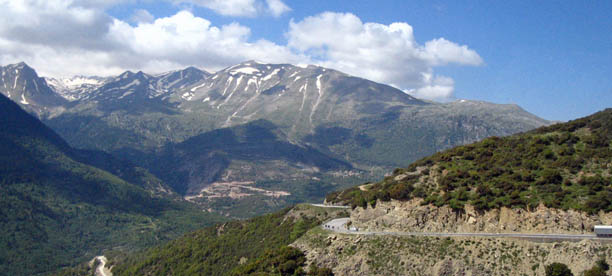 |
|---|
| Katara Pass crossing the Pindos Mountains |
Hours of crouching comfortably on the bus seat and previous days of long walking bestowed me to sleep. When I awoke, I was welcomed by the sight of Ioannina afar, distant by Lake Pamvotis in centre of which was an elongate isle of Nisi. I got myself another ticket to northeast end of Igoumenitsa port at a lowdown bus terminal in Ioannina. It was another two waiting hours before departing, so it was just timely right to take my lunch of chicken souvlaki at a eating bar. Amid eating, I was interrupted by the appearance of a young pretty Chinese student strapping her little shoulder with her box of accessories. In her bewildered, pitiful expression and speaking only conventional Greek, she was persistence in selling her things to two young teens and an old couple. Apparently out of sheer kindness, they bought from her a shaver and a pair of reading glasses. I was stunned and deeply curious to see an Asian girl making a living in this far remoted end of Europe. I broke the ice by hailing her in Mandarin. She spoke about herself with stammering sentences, due to either of the unfamiliar Western environment or in front of another Chinese stranger. Her family was in Italy and she came alone to study under free Greek education, and she was merely selling during weekend to earn extra. I offered her a drink and she nicely declined, instead she left with me her selling item of medical oil and hurried off. I did not get any of her contact, but I wished her safety and well-being in the total foreign land.
It was another three hour of journey, skimming along the sea line and blossomed valleys of yellow flowers. The bus dropped me at the port where I conveniently got another ferry ticket to Corfu. A couple from North Caroline, US was also taking the same boat. In their late 40s of establishing many wrinkles, they were fitter than any young fellows. They told me that they just overcame the freezing Mount Olympus and were going to take a full trek from Corfu north to south in days. I sincerely admired their adventurous spirit and outgoing drive.
It was a simply two-hour sail to Corfu Town, a very first stopover of any island visitors. Heaved heavily with my haversacks, I penetrated through the town street to find some decent stay. To my astonishment, the hotels seemed to be hiding away from me and all I saw were many eating places where the staff was calling me for a meal. Street signs were in small unreadable Greek and they all looked the same, thus I had a long way finding any hotels stated in the guide book. After much probing with the locals, I was backed to the sea port and found the cheap yet highly-recommended Hotel Astron. The room offered a magnificent sea view, and cooling breeze which required no air-conditioned.
After a hectic travel day, I slowed myself down by walking along the port, waiting for the sunset in cloudy orange hue. An amiable middle-aged guy, while waiting any vibrating sign of his fishing rod, offered his cigarette (as a non-smoker, which I declined.) and invited me to take his picture. In the fainting sky, swarms of sparrows chattering nosily and dived around aimlessly. After a quick bite, I wandered deeply down the street which was more bustling as night fell. The Liston, a Parisan-styled row of cafes, was packed with people crowding together on tables, smoking and talking noisily. The red-domed bell tower of Agios Spyridon was seen down many small shopping alleyways selling Corfu's special orange wines. Back to my hotel room, I set my camera firmly to get a nightly-illuminated New Fortress standing majestically over a hill.
May 23 - Corfu
This morning I set foot into the Corfu town street again. Corfu (Kerkyra) town, croweded with Venetican houses of steel-cladded balconies. Household clothes hanging above and across the quiet alleyways were definitely not a pleasant sight to any visitors, but it spelled the simplicity of local lifestyles. I even spotted balcony mesh-caged and converted into a bird sanctuary. After seeing a postcard of Pondikonissi the night before, I was determined to get there and verify its view attractiveness. Located the correct bus kiosk, I paid for the ticket to dedicated bus #2 and then walked a distance to a designated bus stop. I swiftly asked a woman waiting at the same bus stop to ascertain my direction. She nodded quietly, expression hiding under her dark glasses. Standing behind her back, I detected lately that she was weeping as her shoulders trembled occasionally. Suddenly I felt embarrassed of being oblivious of her sorrow earlier.
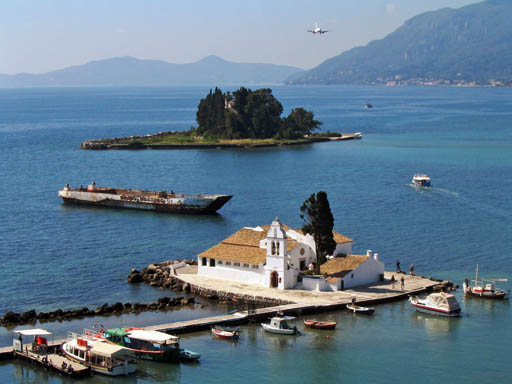 |
|---|
| Pontikonisi, notice the incoming airplane... |
The bus dropped me at an uphill where an outdoor cafe revealing the sapphire-blue image of Pondikonissi ("Mouse Island"). A tiny white convent of Vlaherna was built on the Mouse Island, linked by a narrow causeway. A few steel vessels were scattered around the sea. A domestic airport was adjacent where I was lucky enough to witness an airbus broke through the sky and glided down along the nearby runway. Viewing of Pondikonissi was short-lived, believing that there were more to see in Corfu. Back in Corfu town, there was an interchange near the New Fortress from where buses rode much furthur out of town. I stood squeezily into a tightly-packed bus, only to be called out by the conductor to get another designated bus where I was pampered with a nice seat. Riding out of town gave a short preview of what Corfu was -- vast sea bustled with cargo ships and cruises, inward of which was a hilly temperate forest littered with village houses. I dropped at Palaiokastritsa, a popular beach spot where people read while sun-tanning in nude, swam within the sapphire blue water, took a boat trip to tour around the coves, cycled along the perimeter of cafes and shops. Ill-equipped, I prefered to leave my body dry, stayed walking and had outdoor meal of vinegar octopus meat. It was fairly packed with a friendly family atmosphere. After having a foot dip on the cooling water, I headed back to Old Town again.
The afternoon was unbearably scorching. I was compelled to get a drink from a kiosk boy. Plump in his Hawaii t-shirt, he expressed his cheerfulness in his humourous dialogue. He claimed, "This is paradise!" I hardly disagreed, compared with several Asian countries which their people work beyond nine to five. After warded off the heat from a can beverage, I visited the New Fortress. The name might be misleading, given the fact that it was built as early as 1576 to fortify the town. Passing through an echoing tunnel and ascending up a horse-path, I was nearly at the top and rewarded handsomely by the overview profile of Corfu Old Town. Italianate buildings clustered in their time-aged browns, left no space occupied. Sparrows flocked around the sky, squeaking audibly. I was lucky that I did not receive any of their sky-dropping wastes. Next to a domed bricked tower hoisted the blue-and-white strip of Greece flag, flying elegantly. I explored furthur into the walled interior where small window outlets were tapered down from where ancient soldiers where used to pour hot oils or aim their arrows without exposing too much of themselves.
Then I strolled along the cobbled-paved street in the daytime of Corfu Old Town. The Liston was still overrun by cafe patrons. Walking furthur east, I faced the sea above where the Old Fortress was towered. This ruin was dated back around 1550, relatively older than the New Fortress. Beside it was a venue where speedboat was parked and families swam in the sealine within a safe zone. The town hurried no one, which I soon got bored by its simple tranquilly. The next day I intended to go back to Greece mainland again, so I purchased a early return ticket to Ioannina. While heading back to hotel, I was intercepted at a road bend by a restaurant manager who convinced me to take his dinner by offering free red wine. Beside was a small convent where a white-bearded monk caretaker in his black Orthodox outfit was not shy from my camera. The night was mostly spent in the hotel room, eating oranges while admiring the lit-up New Fortress and sea panorama at the harbour again, at the backdrop noise of soaring sparrows...
 |
|---|
| Corfu Old Town, as seen from New Fortress |
May 24 - Corfu to Metsovo
I skipped my hotel breakfast mainly, taking only a quick sip of orange juice. Heaving my backpacks, I walked out to the street as early as six in the morning. At the bus terminal, I waited patiently, trying to find to the departing bus to be lifted by a ship to cross the strait. Even though I noticed a queue of passengers waiting to board a bus and questioned their destinations, I could not deduce whether it was the correct bus or not as they spoke little English. Even the driver seemed to mind his own business. By the time someone told me that it was the correct bus to get on, it had left minutes ago! I strode down to the port in hurry, hoping that the ship had not left the shore with the bus. The suspense heightened as I could not confirm which parked vessals I should get on, from any locals who barely spoke English. The language barrier hit me evidently and abruptly. Time was running out shortly, and my anxiety overwhelmed me as I wandered helplessly in the port area sized of multiple football fields. I began to give out searching and thought of forfeiting my present ticket and getting another to board the next ship. Fortunately, my persistence in asking around whoever I met paid off, when an experienced German tour guide advised me in fluent English to look for the ship at the very far end of the port. I dashed away while the haversack kept pounding on my shoulder. Thank goodness I managed to locate the familiar coach bus located in a cruise and boarded delightfully at a fee. As the 'Amazing Race' moment was over, I was already sweating hard and panting heavily. While taking a rest at a cabin, I was watching the television broadcasting the Greece's national victory by Helena in an European MTV competition.
 |
|---|
| A Vlach grandma at Metsovo |
At the port of Igoumenitsa, I paced up to ensure that I got into the bus before it departed. It was hours of wriggling around the hill contours in green. A small drama was playing inside the vehicle as a Jewish tourist, car-sicked, vomitted out and crouched in pain while his buddy looked helpless in his plight. Later, the driver called me to alight at an unfamiliar bus-stop at the outskirt of Ioannina. When I said that I was going to Metsovo, he offered little help by telling me to stay at this bus stop without furthur elaboration. Waited for about an hour, there was no sign of any coach heading to Metsovo and time was running out to catch the next bus schedule. (I took a snapshot of bus timetable days before.) So I decided to take a shuttle bus to Ioannina inner town. A college girl kindly informed me that it was heading to a local bus terminal, distance away from an inter-city bus interchange where I could catch the correct coach to Metsovo. I alighted earlier, losing myself for a moment in the street maze. Thankfully to my guide book with Ioannina map, I followed it faithfully and managed to get back the interchange where I had been two days ago. Again, I visited to the same cafe where I met the Asian girl for a hasty meal, but the only figure I was familiar of was the frail-looking cafe owner diligently roasting rows of stewed chicken.
By mid-afternoon, I arrived at Metsovo. Although I was not really eager to come here, I was in delightful relief to reach on schedule after overcoming the journey hiccups. I was so fed up of carrying my backpack for nearly a day that I yearned badly for a room to unload it. Thus the moment I went into a presentable hotel, I struck a deal instantly to the staff who gave reasonable rate during this low peak season. Even in the cloudy day of imminent drizzle, my curiosity compelled me to visit this small mountaineous town. There were several drinking fountains within a stony shelter, drained from the surrounding Pindos Mountain. The town were mainly made of low house roofed in red, clinging on the hill slope. It was originally a small shepherd village of Vlach minority. The nomadic Vlach shepherds were still found normally sitting on the benches of square hall, staring at nowhere. They were easily recognized by their usual black suit, black cap and shepherd crooks. I encountered a female Vlach counterpart in black and red embroidery. She posed herself in front of my camera without grudge. Later she mumbled something to me; after translation from a stranger, I learnt that she liked me, probably I reminded her of her grandson...
The town often invited intermediate rains, and I sought shelters in shops and even a small butchery stall, where two friendly ragged guys invited me to witness their cutting over the beef meats. I walked aimlessly, and entered a quiet wet park matted in green and yellow wild flowers. Some locals asked whether I was a Japanese and Chinese. When I quoted the latter, they exclaimed, "Ah, Mao Dezong!" Apparently in such layback isolated town, what they knew about Chinese was very much limited in the cold-war era. Bypassed a grey church hidden in between trees, I was at an edge overlooking the faraway Pindos mountain range. Covered at both ends of town within an hour or so, I had to admit that the town was kind of lackluster. Most of the restaurants were closed near evening and I had to find around for my dinner. The night drew near, the town was even more silent. What would a better place to take refuge and have a good night sleep than my hotel room...?
May 25 - Metsovo to Athens
I was heading back to the capital of Greece, Athens, hours of ride from Metsovo. After a buffet breakfast, I waited at the town hall for a bus to Trikala, a metropolitan city where I should easily get a ticket to Athens. It took a reversed route crossing the Pindos Mountains again. Skirting along the Meteora, its rock peaks still looked majestic from afar. Did I mention that how I wish I could stay longer in Meteora?
I was in Trikala city by lunchtime. Contrary to the humble shepherds of Metsovo, the Trikala locals were city-wise and dressed in fashion. Many travelled around in bicycles, as Trikala was reputed to be biker friendly. As I had a bus to catch in an hour time, I did not visit this city long, other than having a meal in a family-owned cafe and warmly served by an old pleasant lady.
Long way south to Athens, it took nearly half a day. The passing view of lowland farm plains were less attractive. I resorted to my MP3 player to kill time, forcing myself to sleep if possible. In late afternoon at Athens, I had to quickly find an accommodation before night fall. Based on my previous days of hotel-staying, I was optimistic in getting a room 50Euro per night. Walking near a main road nearly half an hour, I found myself at a metro station which I took a ride to the popular Monastiraki. Unfortunately, finding a cheap hotel was too ideal as the youth hostel was fully booked and many hotels jutted up their rates for the imminent tourist season. Close to finish my trip, my cash was nearly depleted. Therefore just to compare various hotel price, I spent an hour and half, trudging up and forth the roads with heavy load. Finally, I compromised for a room of 60Euro per night at Hotel Metropolis. It was situated at second level where its balcony and window were curtained by the crawling green plants, ensuring my privacy. I had enough of scurrying around Greece and Greek islands, and decided to make Athens my final stop. As for the remaining days, I would slow my pace and take it easy...
May 26 - Athens
I walked southward towards the Acropolis, passing through the Monastiraki street which only few shops and cafes were opened in such early dawn. Before paying a standard visit to Acropolis, I sat outside of a cafe, enjoying my quiet breakfast. But my tranquil was stirred up when a group of kids marched disorderly for an outing visit. I quickly pointed out my camera towards them. Most of them were proactively waving and making noise to me; so much so that two girls fell down as they waved and were told off by their teacher. The cafe owner and I laughed at their innocent blunder.
Counted myself lucky, I discovered unused ticket stub slotted in between the guide book I borrowed from library, probably left by a previous kind-hearted borrower. Thus most of my visits in the next two day were practically free-of-charge. Acropolis, a grand building constructed by the mid-5th century BC Athenians, was doubtlessly the landmark of Athens as well as the whole of Greece. Leaving my valuable things behind at the west entrance, I was greeted by the Theatre of Dionysos, smaller and less impressive than the other end of Theatre of Herodes Atticus which was greatly resorted with modern sound systems for current outdoor concerts. Skirting along the Acropolis wall to the the Propylaia entrance, I was squeezed into a massive flock of other tourists, indicating the peak season was on the way. The Partheonon would be more magnificent, if there were no crane or scaffold around, but I was told that the Acropolis renewal took all year around and there would always have something to reconstruct. Behind Partheonon at one corner located a museum displaying the Acropolis findings, which included the Calf-Bearer sculpture from Archaic period. Although staff warnings were repetitively given to the visitors not to use flash while shooting and not to touch the exhibits, many of them still did otherwise with absolutely no respect to these antique precious. I shook my head, wondering where the graciousness of these Western tourists was deserted when they came here. I was open-mouthed when I witnessed a lady casually laid on a walled ancient frieze and summoned her husband to snap her posture. Suddenly an angry middle-aged lady visitor pulled forcefully the posing lady away from the display and told her off, "Don't touch, this is a museum." In my heart, I applaused for the little justice done. My outdoor tour around was cut short when it rained and I took refuge on a small cove at the Acropolis perimeter.
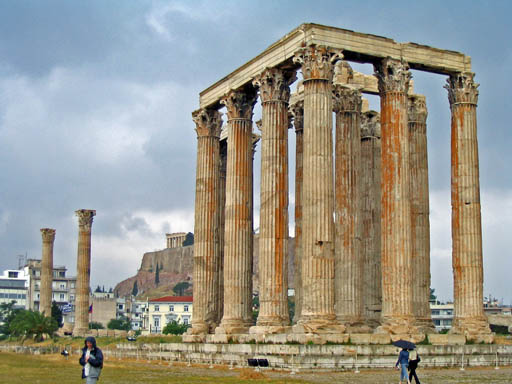 |
|---|
| Temple Of Olympian Zeus |
When the rain stopped, my five-minute walk took me to the nearby Temple of Olympian Zeus. Hadrian's Arch at the roadside welcomed all guests before entering the temple. The temple took 650 years to complete, but its glory was diminished under the changing hand of time; because out of 104 Corinthian columns, only 15 remained. Yet the 15 multi-story high columns left residue of imagination of the grand scale the temple once was. Before I could complete the tour, the fun-spoiling rain fell again and I scurried under a tree for shelter.
I had a quick bite at MacDonald in Monastiraki where it provided a good-for-valued junk food, considering my financial well was drying up soon. I strolled across the nearby Flea Market, mostly commercialized into shophouses under the tourist influx. At the end of the Flea Market, separated by a railway track, was the Ancient Agora. It was once a marketplace as well as political heart for Athenians, now what left were broken columns and mutilated statues. I was uncertain whether the half-human, half-aquatic statue of triton and the headless Roman emperor Hadrian were just duplicates of the real ones preserved in a museum. On top of a small knoll was the Hephaisteion temple, still intact but was charred over time. A more interesting site was the colonnaded building, Stoa of Attalos, much renovated and converted into a museum to house Ancient Agora findings. I was attracted to it by its multiple statues standing in interval on both sides of extended corridor. The interior, housing the Ancient Agora collections was more to see.
 |
|---|
| Stoa of Attalos at Ancient Agora |
Within the Acropolis vicinity, I scaled up the small Areopagos hill to over-gaze the Athens landscape, of which the more prominent features were afar Lykavittos Hill, Ancient Agora and of course, the Acropolis' Parthenon. The wind were striking ferociously and I had to grip my camera tightly for paranomic photographs. The hill top were packed with people, including three Orthodox nuns sitting on the polished rocks. Hostile they might appear in their black robes, but they were actually approachable as they invited me to sit beside them to take a picture.
On a return trail to Monastiraki, I came across the Roman Agora. It was riddled with arrays of rumbled stony columns and wrecked arches, eroding from Roman times. I did not pay to enter the premise; by just gazing at a distance over a fence perimeter, I already appreciated its overall scale, much lesser than Ancient Agora. A remarkable still-intacted artifact in the Agora was the Tower of the Winds, constructed to be both weather vane and water clock, which its outer friezes personifying eight wind directions. I was then back into the Flea Market. Two street sellers sold their artwork in twisting the wires into Greek names, apparently trying to outshine each other and compete in prices. Two Albanian couple set up their stand on the open squares and performed finger water-colouring over glass panels. I was so captivated by their displayed brilliant art pieces that I took long enough to stare and video-shoot to get a tell-off by the hostile Albanian guy. It was another meal in the same MacDonald restaurant before processing to my hotel to kill time by watching badly-receptive television.
May 27 - Athens
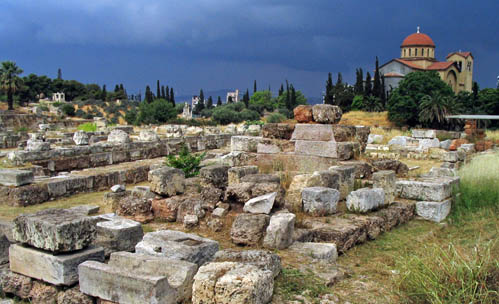 |
|---|
| Kerameikos, in the background was Agia Triada church |
A walk to a fast-food cafe for breakfast led me to another encounter of the Greece geniality. At the Church of Kapnikarea beside which was a purple-blossomed tree, an old man with his thin smiling eyes circled with wrinkles suddenly broke the ice with me in short Chinese and English. He told me that he had been in Beijing to pick up some conventional Chinese phases which he was constantly vocalising to me. In his otherwise fluent English, he pinpointed the location of the Central Market which gave me an place to visit in the next and last morning.
I walked about an hour to reach Kerameikos, an ancient cemetery since the 12th century BC. At the entrance was an indoor museum to display the actual funerary artifact and grave steles extracted from this burial ground. One grave stele, showing a figurine horseman killing a fallen soldier, depicted the heroic character of a young man who was killed during the Corinthian War. Another was a equal-scaled Marble Bull from Dionysious. However, most of the tomb steles, however, were normally craved out to portray the griefs of families and servants of the decreased. Even though at different time periods and civilizations, the custom expressions towards death varied, the sorrow over departing the dead was still universal. The open green land of the Street of Tombs was littered with stone bricks and half pillars. Honestly I did not know what I was watching at only replicas of gravesteon of once Athens' riches and famous, but the garden flowers, blooming in striking orange and purple with church of Agia Triada as backdrop, caught my attention.
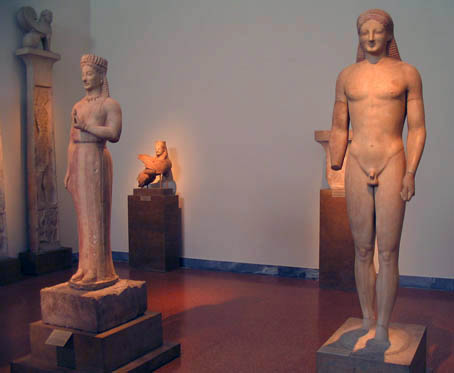 |
|---|
| Kourai (right) and its female couterpart Korai (left) |
A train transported me downtown and within a walking distance, I was at the renowned National Archaeological Museum of Athens. Main sections were concentrated in the ground level; the first section to browse around after ticket-checking was the Prehistoric Collection which contained Neolithic and Cycladic figurines, abstract and contemporary-like. The most famous of all was the Death Mask of Agamemnon (you know, the king who was in trifle with Brad Pitt's role as Archille in movie 'Troy') The museum time-wrapped me into progressing period in Greece. Sculptures had grown into human-sized and were more elaborate in their postures and facial expression, starting from the Sounion Kouros and Korai, Olympican sportsmen, to the Roman Emperors. Admittedly the museum was not as grand and complex as the Louvre Museum, nevertheless it signified the richness of Greek civilizations. Incidentally I encountered the Taiwanese couple from Meteora here, who likewise spent hours admiring the artifacts. Surprisingly of all, they stayed in the same hotel!
The rest of the afternoon was a long stroll from downtown to city central, from Monastiraki to Plaka, another touristic neighbourhood in the heart of Acropolis region. I had to watch incoming automobiles, even in a narrow track which seemed to be fit only for pedestrians. Driving in this city was less traffic-friendly (less signs and lights) and I had encountered two bickerings by drivers over their rights to pass through the no-divider roads. In the evening, I was mixing within the local crowds as the street started busy. Street musicians and sellers were everywhere; a group of Red Indians even staged their superb vocal performances in their hood and feathered headwears to advertise their music discs. Next to the Parliament House was the Syntagma Square where hotshot juveniles were skate-boarding while the tiring commuters were busy entering the Syntagma Metro station which had a mini museum housing articles evacuated out during Metro underground construction . While I was sitting on the bench at the square watching fire-throwing street acrobat, an old man voluntarily offered me a nice chit chat from which I was educated about Greece free educational scheme and Athens Olympic Games. He claimed Athens was the one of the safest cities; I hardly disagreed, otherwise I would not still be in the square at the imminent nightfall. Before bedtime, I had another round of conversation with the Taiwanese couple in my room, over our past tour encounters. Like me, they were leaving this country the next day...
May 28 - Athens
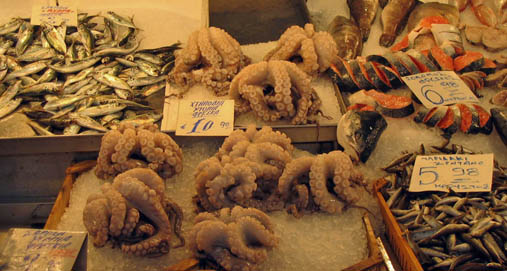 |
|---|
| Morning Fish Market |
The Central Market, recommended by the old man, was only a short walking distance from Monastiraki. My direction was confirmed by the loud price callings from the market stallers. The first place I visited was the meat market. It offered no pleasant sights as the eye-propping lambs and half-bodied pigs were dangling bloodily in display. For a while, I was considering of converting into a vegetarian. The butchers were very receptive in letting me taking their pictures, usually in funny postures with their grossy products. Just around the corner was the fish market selling fine assortments of fishes, squids and clams, less bloody but still noisy. The stallers occasionally sang out loud together, as if they were mocking at or celebrating with someone. Everytime I pointed my lens at them, they were always ready to put up their best smiles and postures. Everyone looked happy-go-lucky within a community and there spelled no ugly competitions. Perhaps although their working environment was wet and loud, they derived happiness from it. Just off the road was the vegetable market, less peaceful and dramatic. There were two or three pet stores caging several species of birds and rodents.
In mid-afternoon, I checked out the hotel and had my one last meal in MacDonald. (Did I mention that I had fed up with the fast junky food by now?) I bought a metro ticket to airport at the Syntagma station, pricy than normal . The metro cabins looked new and refreshing with no vivid vandalized signs, probably revamped for the no-longer-ago Olympic Games. While looking at the fast-forwarding views outside, I recollected the journey I had been through. No doubt the tour was far from prefect, it was the warmth from the local people which made it memorable. It was quite different from my usual nature trips less of the provincial interpersonal touches. I wondered whether I had next opportunity to travel in other Greek Islands such as Rhodes...but if there was, I wish to share this romancing elements of these islands with my wife.